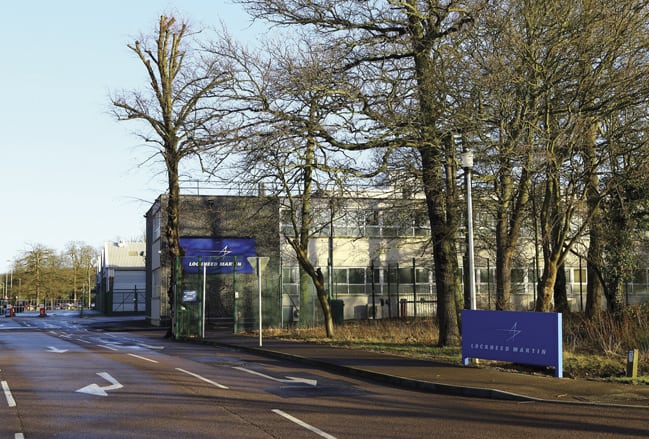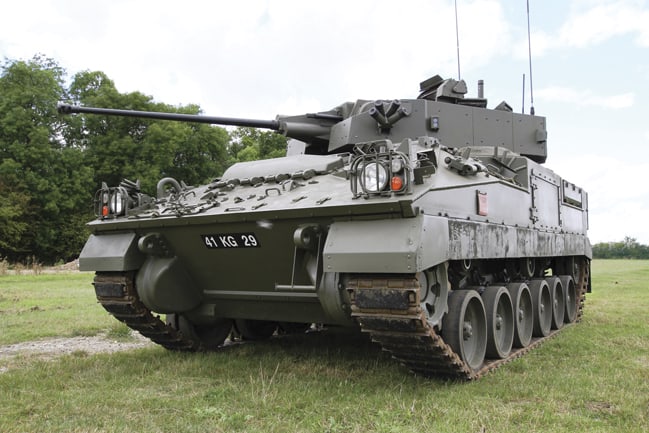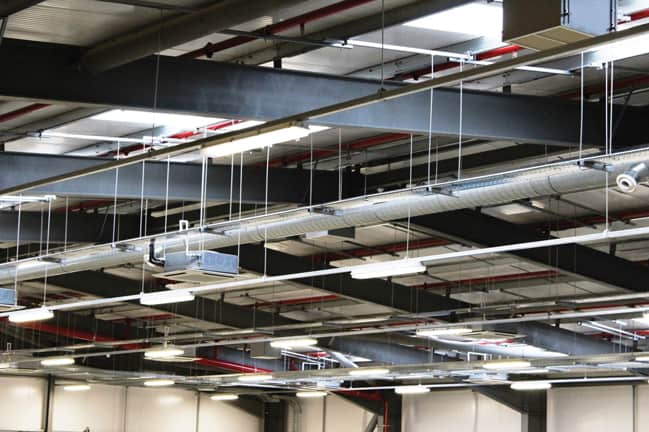Tucked away just to the north of the small Bedfordshire town from which it takes its name, the Ampthill site of Lockheed Martin UK is one of 21 locations across the UK owned by the US multinational. It currently employs some 922 people in the design, development and production of various high-technology systems in areas such as aerospace and defence.

Graham Harraway, operations director at Ampthill, explained that the 64-acre site is the only one in the UK that is wholly owned by the company and, since it was acquired a little over a decade ago, has had about £23m invested in it. He said that the site covers vehicle systems; mission support; and special projects. It is currently working on substantial projects for the turrets of the Scout SV and Warrior armoured vehicles used by the British Army.
At present, surprisingly few of those on site, only about 120, are involved in direct manufacturing or related support activities. Harraway explained that given that the current focus is on development work for the Scout and Warrior turrets there are some 449 engineering personnel in those initiatives. Those numbers will, though, rebalance as the two contracts transition through to manufacturing – a flexibility aided by the fact that around a fifth of the development personnel involved are contractors rather than permanent employees.
Actual manufacturing activities include composites production, electronics installation, machining, grit-blasting and painting, as well as inspection routines using a coordinate measurement machine. The wide range of operations at the site is facilitated, Harraway added, by canny use of multi-skilling. Some of the CNC machinists, for instance, are also qualified wiring technicians.
But as with any manufacturing business, the bottom line of profitability depends on many factors, not least the energy efficiency of its operations. Last year it became the first site operated by Lockheed Martin to gain the ISO50001 energy management standard. In fact, it is now described by the company as its ‘greenest’ site in the UK.

Harraway said that gaining the standard presented itself as an appropriate option for the company as it looked ahead to the time when current development projects would morph into necessarily more energy-intensive manufacturing. Moreover, the preponderance of defence-related work carried out at the site means that work there is already governed by a number of extremely demanding procedural standards common in that area. He mentioned, for instance, the AS9100 quality management standard.
As such, Harraway explained, there is already a lot of familiarity with measuring and managing. Moreover, he added that an initial assessment of what the standard could offer confirmed very importantly that it included an emphasis on continuous improvement that could be implemented in a structured manner.
Energy savings had, in any case, been perceptibly increasing in importance as a target area for improving efficiencies since 2010.

That was when the company carried out a structured improvement exercise in response to its recognition that it simply could not measure what its energy consumption actually was down at shopfloor level. “We knew what we were spending on electricity, but we didn’t know what the key drivers were,” Harraway explained. A very basic reason for that was that there was no sub-metering at all on the site; the only quantitative measurement of electricity usage was of the total amount consumed. But given the additional price volatility for heating oil one thing was clear: the site was spending too much money satisfying its energy needs.
Accordingly over the next few years, Ampthill was the location for a series of initiatives aimed at both assessing and beginning to tackle the causes of that situation. A start was made on introducing sub-metering, for instance, with some 20 monitoring points identified and kitted out appropriately. External consultants were used to analyse particular areas of energy consumption including IT servers, HVAC and lighting. The latter, by the way, came up with the rather astounding finding that nearly 1,200 different types of lighting unit were utilised at the site.
Moreover, all of this activity produced some tangible results. Oil consumption at the site, for example, was £364,000 in 2007 and only £66,000 in 2015.
But it was in October 2014 that the decision was taken to pursue an ISO50001 approach. The date is provided by Ian Martin, environmental safety and health manager. He said that although by then the site had stepped up its energy-related efficiency activities even further by formally auditing its energy consumption under the terms of the UK government’s Energy Savings Opportunity Scheme (ESOS), it nevertheless realised that the scheme was limited in its potential, not least because it imposed no mandatory requirements for remedial action. “We wanted something that could take us to another level,” he said.
Martin himself led the small team set up to spearhead the initiative. He said it comprised individuals from each of the five EESH (energy, environment, safety and health) zones into which the site is divided, plus a similar individual from a higher corporate level. Actually gaining the standard took roughly six months starting from the pre-qualification audit in January 2015 through the achievement of Stage 1 in March and Stage 2 in June of that year.
An example Martin cited of the type of difference compliance with the standard makes is the requirement it imposes to take into account the energy-efficiency implications of all capital investment decisions. But the aspect he identified as particularly crucial is the demand it makes for energy-review procedures. These, Martin indicated, essentially involve a holistic analysis of energy consumption across all aspects of the organisation that in turn supports the formulation of appropriate monitoring and measurement plans to facilitate enhanced energy efficiency.
In practical terms, that meant a significant increase in the intensity of sub-metering at the site. Martin reported that the number of sub-meters used to monitor localised electricity consumption has already gone up to 77. Areas currently sub-metered from the main incomer include all transformers and distribution boards, as well as individual items of equipment that have been identified as particularly energy intensive in their operation. The latter include, for instance, the hydroclave used in composites material production and also CNC machine tools. Moreover, this is a continuing process. Martin confirmed that by the middle of this year the number of sub-meters should reach a hundred.
All the data gathered in this way is networked back to central energy monitoring point running
a software system called SEEview that is, in fact, a Lockheed Martin product to provide a breakdown of energy consumption across the site. But, as Harraway explained, a hugely important implication of the availability of this data is that it will enable reduced energy consumption at the machine level by the relevant operator. “When we start to engage them with the metering so that they can appreciate when they are using the most energy they are the ones who will come up with the solutions,” he said.
It is only from around now onwards that the fact of the ISO50001 standard being gained will start to impact significantly on the day-to-day experience of most shopfloor personnel. This is not, of course, to say that environmental concerns and energy efficiency were not on the radar before. Harraway said that was manifested by, for instance, the prior existence of the five EESH zones, the ESOS work and an intensive recycling programme that in 2015 saw the site recycle 142 tons of non-hazardous waste out of the 163 tons it produced.
“We are adding to that,” Harraway observed. What employees will begin to notice increasingly from now on, therefore, is the amount of information about energy usage that will inform their teamworking and related target setting.
Nevertheless the standard is also manifested in more tangible ways simply by the adoption of various new types of energy-efficient hardware that are now found around the site. External lighting, for instance, that previously relied on halogen or sodium bulbs rated at 200-400W now utilises led units rated at 16-18W.
Internal illumination for existing manufacturing areas is transitioning towards reliance on miniature fluorescent tubing complying with the ‘T5’ specification rather than the larger T12 and T8 types used previously. The former lighting units in one manufacturing building, for instance, were 60x400W high bay fittings. These were replaced with Tamlite Hilux 380(T5) units that have an efficiency of 94.3 per cent and a luminous efficacy of 73.53lm/W. The cost saving is
£3,500 per annum.
The ultimate objective, though, will be reliance entirely on led units. On-off switching is also now increasingly effected by means of activity sensors rather than manual switches that can be left on needlessly. The state of the art for the site in all respects will be represented by a completely
new £5.5m manufacturing facility specifically intended for the Scout SV and Warrior projects that is due to become operational in the summer of this year.
The process of gaining the standard was accomplished fairly quickly although Harraway and Martin concurred that doing so was not easy and more difficult than anticipated. As Martin explained, it is not a simple matter of following a set of instructions and actual implementation confronts those involved with nuances that require original thinking
to be solved. Harraway said when the project started, energy-related thinking at Ampthill was at the building level but that this had to be driven down to a machine level.
In 2016 relevant site objectives include:
- not to exceed an annual figure of 5,200MWh for its electricity consumption;
- establish the energy that is required to manufacture a turret once the design has been frozen to allow setting of energy-efficiency objectives in 2017 for the Warrior and Scout programmes; and
- embed the energy management system aligned to the monitoring and measurement plan for each zone, so that it leads to appropriate objectives and targets for site energy consumption in 2017.
They also include ensuring the continuation of the site’s ISO50001 certification. The company said that it is now reviewing the work completed at Ampthill with a view to adopting the procedures it has pioneered elsewhere.










Oxa launches autonomous Ford E-Transit for van and minibus modes
I'd like to know where these are operating in the UK. The report is notably light on this. I wonder why?